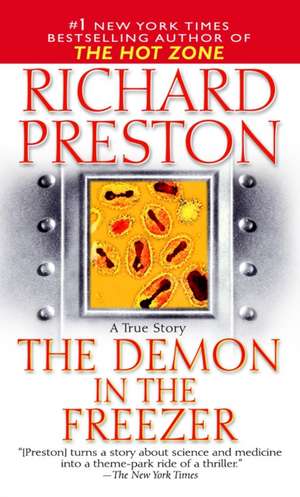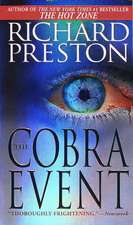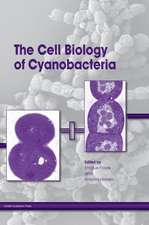The Demon in the Freezer: A True Story
Autor Richard Prestonen Limba Engleză Paperback – 31 iul 2003
Vezi toate premiile Carte premiată
L.A. Times Book Prize (2002)
the drama of the front lines.”
-Richard Danzig, former secretary of the navy
The first major bioterror event in the United States-the anthrax attacks in October 2001-was a clarion call for scientists who work with “hot” agents to find ways of protecting civilian populations against biological weapons. In The Demon in the Freezer, his first nonfiction book since The Hot Zone, a #1 New York Times bestseller, Richard Preston takes us into the heart of Usamriid, the United States Army Medical Research Institute of Infectious Diseases at Fort Detrick, Maryland, once the headquarters of the U.S. biological weapons program and now the epicenter of national biodefense.
Peter Jahrling, the top scientist at Usamriid, a wry virologist who cut his teeth on Ebola, one of the world’s most lethal emerging viruses, has ORCON security clearance that gives him access to top secret information on bioweapons. His most urgent priority is to develop a drug that will take on smallpox-and win. Eradicated from the planet in 1979 in one of the great triumphs of modern science, the smallpox virus now resides, officially, in only two high-security freezers-at the Centers for Disease Control in Atlanta and in Siberia, at a Russian virology institute called Vector. But the demon in the freezer has been set loose. It is almost certain that illegal stocks are in the possession of hostile states, including Iraq and North Korea. Jahrling is haunted by the thought that biologists in secret labs are using genetic engineering to create a new superpox virus, a smallpox resistant to all vaccines.
Usamriid went into a state of Delta Alert on September 11 and activated its emergency response teams when the first anthrax letters were opened in New York and Washington, D.C. Preston reports, in unprecedented detail, on the government’s response to the attacks and takes us into the ongoing FBI investigation. His story is based on interviews with top-level FBI agents and with Dr. Steven Hatfill.
Jahrling is leading a team of scientists doing controversial experiments with live smallpox virus at CDC. Preston takes us into the lab where Jahrling is reawakening smallpox and explains, with cool and devastating precision, what may be at stake if his last bold experiment fails.
From the Hardcover edition.
Preț: 54.21 lei
Nou
Puncte Express: 81
Preț estimativ în valută:
10.38€ • 11.27$ • 8.72£
10.38€ • 11.27$ • 8.72£
Carte disponibilă
Livrare economică 31 martie-14 aprilie
Preluare comenzi: 021 569.72.76
Specificații
ISBN-13: 9780345466631
ISBN-10: 0345466632
Pagini: 304
Dimensiuni: 105 x 176 x 21 mm
Greutate: 0.15 kg
Editura: Fawcett Books
ISBN-10: 0345466632
Pagini: 304
Dimensiuni: 105 x 176 x 21 mm
Greutate: 0.15 kg
Editura: Fawcett Books
Notă biografică
Richard Preston is the author of The Hot Zone, a #1 New York Times bestseller, and of The Cobra Event, a bioterror thriller, also a New York Times bestseller. A writer for The New Yorker since 1985, Preston won the American Institute of Physics award and is the only nondoctor ever to have received the CDC’s Champion of Prevention award. He has an asteroid named after him and lives outside of New York City.
From the Hardcover edition.
From the Hardcover edition.
Extras
Chapter 1
Something in the Air Journey Inward
OCTOBER 2-6, 2001
In the early nineteen seventies, a British photo retoucher named Robert Stevens arrived in south Florida to take a job at the National Enquirer, which is published in Palm Beach County. At the time, photo retouchers for supermarket tabloids used an airbrush (nowadays they use computers) to clarify news photographs of world leaders shaking hands with aliens or to give more punch to pictures of six-month-old babies who weigh three hundred pounds. Stevens was reputed to be one of the best photo retouchers in the business. The Enquirer was moving away from stories like "I Ate My Mother-in-Law's Head," and the editors recruited him to bring some class to the paper. They offered him much more than he made working for tabloids in Britain.
Stevens was in his early thirties when he moved to Florida. He bought a red Chevy pickup truck, and he put a CB radio in it and pasted an American-flag decal in the back window and installed a gun rack next to the flag. He didn't own a gun: the gun rack was for his fishing rods. Stevens spent a lot of time at lakes and canals around south Florida, where he would spin-cast for bass and panfish. He often stopped to drop a line in the water on his way to and from work. He became an American citizen. He would drink a Guinness or two in bars with his friends and explain the Constitution to them. "Bobby was the only English redneck I ever knew," Tom Wilbur, one of his best friends, said to me.
Stevens's best work tended to get the Enquirer sued. When the TV star Freddie Prinze shot himself to death, Stevens joined two photographs into a seamless image of Prinze and Raquel Welch at a party together. The implication was that they had been lovers, and this sparked a lawsuit. He enhanced a photograph of a woman with a long neck: "Giraffe Woman." Giraffe Woman sued. His most famous retouching job was on a photograph of Elvis lying dead in his coffin, which ran on the cover of the Enquirer. Elvis's bloated face looked a lot better in Stevens's version than it did in the handiwork of the mortician.
Robert Stevens was a kindhearted man. He filed the barbs off his fishing hooks so that he could release a lot of the fish he caught, and he took care of feral cats that lived in the swamps around his house. There was something boyish about him. Even when he was in his sixties, children in the neighborhood would knock on the door and ask his wife, Maureen, "Can Bobby come out and play?" Not long before he died, he began working for The Sun, a tabloid published by American Media, the company that also owns the National Enquirer. The two tabloids shared space in an office building in Boca Raton.
on thursday, September 27th, Robert Stevens and his wife drove to Charlotte, North Carolina, to visit their daughter Casey. They hiked at Chimney Rock Park, where each autumn brings the spectacular sight of five hundred or more migrating hawks soaring in the air at once, and Maureen took a photograph of her husband with the mountains behind him. By Sunday, Stevens was not feeling well. They left for Florida Sunday night, and he got sick to his stomach during the drive home. On Monday, he began running a high fever and became incoherent. At two o'clock on Tuesday morning, Maureen took him to the emergency room of the John F. Kennedy Medical Center in Palm Beach County. A doctor there thought he might have meningitis. Five hours later, Stevens started having convulsions.
The doctors performed a spinal tap on him, and the fluid came out cloudy. Dr. Larry Bush, an infectious-disease specialist, looked at slides of the fluid and saw that it was full of rod-shaped bacteria with flat ends, a little like slender macaroni. The bacteria were colored blue with Gram stain-they were Gram-positive. Dr. Bush thought, anthrax. Anthrax, or Bacillus anthracis, is a single-celled bacterial micro-organism that forms spores, and it grows explosively in lymph and blood. By Thursday, October 4th, a state lab had confirmed the diagnosis. Stevens's symptoms were consistent with inhalation anthrax, which is caused when a person breathes in the spores. The disease is extremely rare. There had been only eighteen cases of inhalation anthrax in the past hundred years in the United States, and the last reported case had been twenty-three years earlier. The fact that anthrax popped into Dr. Bush's mind had not a little to do with recent news reports about two of the September 11th hijackers casing airports around south Florida and inquiring about renting crop-dusting aircraft. Anthrax could be distributed from a small airplane.
Stevens went into a coma, and at around four o'clock in the afternoon of Friday, October 5th, he suffered a fatal breathing arrest. Minutes later, one of his doctors made a telephone call to the Federal Centers for Disease Control and Prevention-the CDC-in Atlanta, and spoke with Dr. Sherif Zaki, the chief of infectious-diseases pathology.
Sherif Zaki inhabits a tiny office on the second floor of Building 1 at the CDC. The hallway is made of white cinder block, and the floor is linoleum. The buildings of the CDC sit jammed together and joined by walkways on a tight little campus in a green and hilly neighborhood in northeast Atlanta. Building 1 is a brick oblong with aluminum-framed windows. It was built in the nineteen fifties, and the windows look as if they haven't been cleaned since then.
Sherif Zaki is a shy, quiet man in his late forties, with a gentle demeanor, a slight stoop in his posture, a round face, and pale green eyes distinguished by dazzling pupils, which give him a piercing gaze. He speaks precisely, in a low voice. Zaki went out into the hallway, where his pathology group often gathered to talk about ongoing cases. "Mr. Stevens has passed away," he said.
"Who's going to do the post?" someone asked. A post is a postmortem exam, an autopsy.
Zaki and his team were going to do the post.
early the next morning, on Saturday, October 6th, Sherif Zaki and his team of CDC pathologists arrived in West Palm Beach in a chartered jet, and a van took them to the Palm Beach County medical examiner's office, which takes up two modern, one-story buildings set under palm trees on a stretch of industrial land near the airport. They went straight to the autopsy suite, carrying bags of tools and gear. The autopsy suite is a large, open room in the center of one of the buildings. Two autopsies were in progress. Palm Beach medical examiners were bending over opened bodies on tables, and there was an odor of fecal matter in the air, which is the normal smell of an autopsy. The examiners stopped work when the CDC people entered.
"We're here to assist you," Zaki said in his quiet way.
The examiners were polite and helpful but did not make eye contact, and Zaki sensed that they were afraid. Stevens's body contained anthrax cells, although he had not been dead long enough for the cells to become large numbers of spores. In any case, any spores in his body were wet, and wet anthrax spores are nowhere near as dangerous as dry spores, which can float in the air like dandelion seeds, looking for fertile ground.
The CDC people opened a door in the morgue refrigerator and pulled out a tray. The body had been zipped up inside a Tyvek body bag. Without opening the bag, they lifted the body up by the shoulders and feet and placed it on a bare metal gurney. They rolled the gurney into a supply room and closed the door behind them. They would do the autopsy on the gurney in a closed room, to prevent the autopsy tables from being contaminated with spores.
The chief medical examiner of Palm Beach County, Dr. Lisa Flannagan, was going to do the primary incisions, while Zaki and his people would do the organ exams. Flannagan is a slender, self-assured woman, with a reputation as a top-notch examiner. Everybody gowned up, and they put on N-100 biohazard masks, clear plastic face shields, hair covers, rubber boots, and three layers of gloves. The middle glove was reinforced with Kevlar. Then they unzipped the bag.
The CDC team lifted the body up, gripping it beneath the shoulders and legs, and someone snatched the bag out from underneath it. They lowered the body back onto the bare metal deck of the gurney. Stevens had been a pleasant-looking man with a cheerful appearance. He was a bluish color now, and his eyes were half open.
Heraclitus said that when a man dies, a world passes away. The terribly human look on the face of the deceased man disturbed Sherif Zaki. It was so hard to picture this man in life and then to connect that picture with the body on the gurney. This was the toughest thing for a prosector, and you never got over it, really. Zaki did not want to connect the living man with the body. You had to put it aside, and you could not think about it. His duty now was to identify the exact type of disease that Stevens had, to learn if he had inhaled spores or perhaps had become infected some other way. This might help save lives. Yet cutting into an unfathomed body was difficult, and after a hard post, Sherif Zaki would not feel like himself for a week afterward. "It's not an uplifting process," Zaki said to me.
The team rolled Stevens onto his side and inspected his back under bright lights for signs of cutaneous anthrax-skin anthrax. They didn't find any, and they laid him back down.
Dr. Flannagan took up a scalpel and pressed the tip of the blade on the upper left part of the chest under the shoulder. She made a curving incision that went underneath the nipples, across the chest, and up to the opposite shoulder. Then, starting at the top of the sternum, she made a straight incision down to the solar plexus. This made a cut that looked like a Y, but with a curved top. She finished it with a short horizontal cut across the solar plexus. The opening incision looked rather like the profile of a wineglass.
Dr. Flannagan grasped the skin of the chest, and pulled it upward, peeling it off. She laid the blanket of skin around the neck. She pulled the skin away from the sides of the chest, revealing the ribs and sternum. She took up a pair of gardening shears and cut the ribs one by one, snipping them in a wide circle around the sternum. This was to free the chest plate, the front of the rib cage. When she had finished cutting the ribs, she pushed her fingertips underneath the chest plate and pried it upward, as if she were raising a lid from a box.
As Flannagan lifted the chest plate, a gush of bloody fluid poured out from under the ribs and ran down over the body and poured over the gurney and onto the floor.
The chest cavity was engorged with bloody liquid. No one in the room had ever done a post on a person who had died of anthrax. Zaki had studied photographs of autopsies that had been done on anthrax victims in the Soviet Union, in the spring of 1979, after a plume of finely ground anthrax dust had come out of a bioweapons manufacturing facility in Sverdlovsk (Yekaterinburg) and had killed at least sixty-six people downwind, but the photographs had not prepared him for the sight of the liquid that was pouring out of this man's chest. They were going to have quite a time cleaning up the room. The bloody liquid was saturated with anthrax cells, and the cells would quickly start turning into spores when they hit the air.
Dr. Flannagan stood back. It was the turn of the CDC team.
The CDC people wanted to look at the lymph nodes in the center of the chest. Working gently with his fingertips, Zaki separated the lungs and pulled them to either side, revealing the heart. The heart and lungs were drowned in red liquid. He couldn't see anything. Someone brought a ladle, and they started spooning the liquid from the chest. They poured it off into containers, and ultimately they had ladled out almost a gallon of it.
Zaki worked his way slowly down into the chest. Using a scalpel, he removed the heart and parts of the lungs, which revealed the lymph nodes of the chest, just below the fork of the bronchial tubes. The lymph nodes of a healthy person are pale nodules the size of peas. Stevens's lymph nodes were the size of plums, and they looked exactly like plums-they were large, shiny, and dark purple, verging on black. Zaki cut into a plum with his scalpel. It disintegrated at the touch of the blade, revealing a bloody interior, saturated with hemorrhage. This showed that the spores that had killed Stevens had gotten into his lungs through the air.
When they had finished the autopsy, the pathologists gathered up their tools and placed some of them inside the body cavity. The scalpels, the gardening shears, scissors, knives, the ladle-the prosection tools were now contaminated with anthrax. The team felt that the safest thing to do with them would be to destroy them. They packed the body cavity with absorbent batting, stuffing it in around the tools, and placed the body inside fresh double body bags. Then, using brushes and hand-pump sprayers filled with chemicals, they spent hours decontaminating the supply room, the bags, the gurney, the floor-everything that had come into contact with fluids from the autopsy. Robert Stevens was cremated. Sherif Zaki later recalled that when he was ladling the red liquid from Stevens's chest, the word murder never entered his mind.
From the Hardcover edition.
Something in the Air Journey Inward
OCTOBER 2-6, 2001
In the early nineteen seventies, a British photo retoucher named Robert Stevens arrived in south Florida to take a job at the National Enquirer, which is published in Palm Beach County. At the time, photo retouchers for supermarket tabloids used an airbrush (nowadays they use computers) to clarify news photographs of world leaders shaking hands with aliens or to give more punch to pictures of six-month-old babies who weigh three hundred pounds. Stevens was reputed to be one of the best photo retouchers in the business. The Enquirer was moving away from stories like "I Ate My Mother-in-Law's Head," and the editors recruited him to bring some class to the paper. They offered him much more than he made working for tabloids in Britain.
Stevens was in his early thirties when he moved to Florida. He bought a red Chevy pickup truck, and he put a CB radio in it and pasted an American-flag decal in the back window and installed a gun rack next to the flag. He didn't own a gun: the gun rack was for his fishing rods. Stevens spent a lot of time at lakes and canals around south Florida, where he would spin-cast for bass and panfish. He often stopped to drop a line in the water on his way to and from work. He became an American citizen. He would drink a Guinness or two in bars with his friends and explain the Constitution to them. "Bobby was the only English redneck I ever knew," Tom Wilbur, one of his best friends, said to me.
Stevens's best work tended to get the Enquirer sued. When the TV star Freddie Prinze shot himself to death, Stevens joined two photographs into a seamless image of Prinze and Raquel Welch at a party together. The implication was that they had been lovers, and this sparked a lawsuit. He enhanced a photograph of a woman with a long neck: "Giraffe Woman." Giraffe Woman sued. His most famous retouching job was on a photograph of Elvis lying dead in his coffin, which ran on the cover of the Enquirer. Elvis's bloated face looked a lot better in Stevens's version than it did in the handiwork of the mortician.
Robert Stevens was a kindhearted man. He filed the barbs off his fishing hooks so that he could release a lot of the fish he caught, and he took care of feral cats that lived in the swamps around his house. There was something boyish about him. Even when he was in his sixties, children in the neighborhood would knock on the door and ask his wife, Maureen, "Can Bobby come out and play?" Not long before he died, he began working for The Sun, a tabloid published by American Media, the company that also owns the National Enquirer. The two tabloids shared space in an office building in Boca Raton.
on thursday, September 27th, Robert Stevens and his wife drove to Charlotte, North Carolina, to visit their daughter Casey. They hiked at Chimney Rock Park, where each autumn brings the spectacular sight of five hundred or more migrating hawks soaring in the air at once, and Maureen took a photograph of her husband with the mountains behind him. By Sunday, Stevens was not feeling well. They left for Florida Sunday night, and he got sick to his stomach during the drive home. On Monday, he began running a high fever and became incoherent. At two o'clock on Tuesday morning, Maureen took him to the emergency room of the John F. Kennedy Medical Center in Palm Beach County. A doctor there thought he might have meningitis. Five hours later, Stevens started having convulsions.
The doctors performed a spinal tap on him, and the fluid came out cloudy. Dr. Larry Bush, an infectious-disease specialist, looked at slides of the fluid and saw that it was full of rod-shaped bacteria with flat ends, a little like slender macaroni. The bacteria were colored blue with Gram stain-they were Gram-positive. Dr. Bush thought, anthrax. Anthrax, or Bacillus anthracis, is a single-celled bacterial micro-organism that forms spores, and it grows explosively in lymph and blood. By Thursday, October 4th, a state lab had confirmed the diagnosis. Stevens's symptoms were consistent with inhalation anthrax, which is caused when a person breathes in the spores. The disease is extremely rare. There had been only eighteen cases of inhalation anthrax in the past hundred years in the United States, and the last reported case had been twenty-three years earlier. The fact that anthrax popped into Dr. Bush's mind had not a little to do with recent news reports about two of the September 11th hijackers casing airports around south Florida and inquiring about renting crop-dusting aircraft. Anthrax could be distributed from a small airplane.
Stevens went into a coma, and at around four o'clock in the afternoon of Friday, October 5th, he suffered a fatal breathing arrest. Minutes later, one of his doctors made a telephone call to the Federal Centers for Disease Control and Prevention-the CDC-in Atlanta, and spoke with Dr. Sherif Zaki, the chief of infectious-diseases pathology.
Sherif Zaki inhabits a tiny office on the second floor of Building 1 at the CDC. The hallway is made of white cinder block, and the floor is linoleum. The buildings of the CDC sit jammed together and joined by walkways on a tight little campus in a green and hilly neighborhood in northeast Atlanta. Building 1 is a brick oblong with aluminum-framed windows. It was built in the nineteen fifties, and the windows look as if they haven't been cleaned since then.
Sherif Zaki is a shy, quiet man in his late forties, with a gentle demeanor, a slight stoop in his posture, a round face, and pale green eyes distinguished by dazzling pupils, which give him a piercing gaze. He speaks precisely, in a low voice. Zaki went out into the hallway, where his pathology group often gathered to talk about ongoing cases. "Mr. Stevens has passed away," he said.
"Who's going to do the post?" someone asked. A post is a postmortem exam, an autopsy.
Zaki and his team were going to do the post.
early the next morning, on Saturday, October 6th, Sherif Zaki and his team of CDC pathologists arrived in West Palm Beach in a chartered jet, and a van took them to the Palm Beach County medical examiner's office, which takes up two modern, one-story buildings set under palm trees on a stretch of industrial land near the airport. They went straight to the autopsy suite, carrying bags of tools and gear. The autopsy suite is a large, open room in the center of one of the buildings. Two autopsies were in progress. Palm Beach medical examiners were bending over opened bodies on tables, and there was an odor of fecal matter in the air, which is the normal smell of an autopsy. The examiners stopped work when the CDC people entered.
"We're here to assist you," Zaki said in his quiet way.
The examiners were polite and helpful but did not make eye contact, and Zaki sensed that they were afraid. Stevens's body contained anthrax cells, although he had not been dead long enough for the cells to become large numbers of spores. In any case, any spores in his body were wet, and wet anthrax spores are nowhere near as dangerous as dry spores, which can float in the air like dandelion seeds, looking for fertile ground.
The CDC people opened a door in the morgue refrigerator and pulled out a tray. The body had been zipped up inside a Tyvek body bag. Without opening the bag, they lifted the body up by the shoulders and feet and placed it on a bare metal gurney. They rolled the gurney into a supply room and closed the door behind them. They would do the autopsy on the gurney in a closed room, to prevent the autopsy tables from being contaminated with spores.
The chief medical examiner of Palm Beach County, Dr. Lisa Flannagan, was going to do the primary incisions, while Zaki and his people would do the organ exams. Flannagan is a slender, self-assured woman, with a reputation as a top-notch examiner. Everybody gowned up, and they put on N-100 biohazard masks, clear plastic face shields, hair covers, rubber boots, and three layers of gloves. The middle glove was reinforced with Kevlar. Then they unzipped the bag.
The CDC team lifted the body up, gripping it beneath the shoulders and legs, and someone snatched the bag out from underneath it. They lowered the body back onto the bare metal deck of the gurney. Stevens had been a pleasant-looking man with a cheerful appearance. He was a bluish color now, and his eyes were half open.
Heraclitus said that when a man dies, a world passes away. The terribly human look on the face of the deceased man disturbed Sherif Zaki. It was so hard to picture this man in life and then to connect that picture with the body on the gurney. This was the toughest thing for a prosector, and you never got over it, really. Zaki did not want to connect the living man with the body. You had to put it aside, and you could not think about it. His duty now was to identify the exact type of disease that Stevens had, to learn if he had inhaled spores or perhaps had become infected some other way. This might help save lives. Yet cutting into an unfathomed body was difficult, and after a hard post, Sherif Zaki would not feel like himself for a week afterward. "It's not an uplifting process," Zaki said to me.
The team rolled Stevens onto his side and inspected his back under bright lights for signs of cutaneous anthrax-skin anthrax. They didn't find any, and they laid him back down.
Dr. Flannagan took up a scalpel and pressed the tip of the blade on the upper left part of the chest under the shoulder. She made a curving incision that went underneath the nipples, across the chest, and up to the opposite shoulder. Then, starting at the top of the sternum, she made a straight incision down to the solar plexus. This made a cut that looked like a Y, but with a curved top. She finished it with a short horizontal cut across the solar plexus. The opening incision looked rather like the profile of a wineglass.
Dr. Flannagan grasped the skin of the chest, and pulled it upward, peeling it off. She laid the blanket of skin around the neck. She pulled the skin away from the sides of the chest, revealing the ribs and sternum. She took up a pair of gardening shears and cut the ribs one by one, snipping them in a wide circle around the sternum. This was to free the chest plate, the front of the rib cage. When she had finished cutting the ribs, she pushed her fingertips underneath the chest plate and pried it upward, as if she were raising a lid from a box.
As Flannagan lifted the chest plate, a gush of bloody fluid poured out from under the ribs and ran down over the body and poured over the gurney and onto the floor.
The chest cavity was engorged with bloody liquid. No one in the room had ever done a post on a person who had died of anthrax. Zaki had studied photographs of autopsies that had been done on anthrax victims in the Soviet Union, in the spring of 1979, after a plume of finely ground anthrax dust had come out of a bioweapons manufacturing facility in Sverdlovsk (Yekaterinburg) and had killed at least sixty-six people downwind, but the photographs had not prepared him for the sight of the liquid that was pouring out of this man's chest. They were going to have quite a time cleaning up the room. The bloody liquid was saturated with anthrax cells, and the cells would quickly start turning into spores when they hit the air.
Dr. Flannagan stood back. It was the turn of the CDC team.
The CDC people wanted to look at the lymph nodes in the center of the chest. Working gently with his fingertips, Zaki separated the lungs and pulled them to either side, revealing the heart. The heart and lungs were drowned in red liquid. He couldn't see anything. Someone brought a ladle, and they started spooning the liquid from the chest. They poured it off into containers, and ultimately they had ladled out almost a gallon of it.
Zaki worked his way slowly down into the chest. Using a scalpel, he removed the heart and parts of the lungs, which revealed the lymph nodes of the chest, just below the fork of the bronchial tubes. The lymph nodes of a healthy person are pale nodules the size of peas. Stevens's lymph nodes were the size of plums, and they looked exactly like plums-they were large, shiny, and dark purple, verging on black. Zaki cut into a plum with his scalpel. It disintegrated at the touch of the blade, revealing a bloody interior, saturated with hemorrhage. This showed that the spores that had killed Stevens had gotten into his lungs through the air.
When they had finished the autopsy, the pathologists gathered up their tools and placed some of them inside the body cavity. The scalpels, the gardening shears, scissors, knives, the ladle-the prosection tools were now contaminated with anthrax. The team felt that the safest thing to do with them would be to destroy them. They packed the body cavity with absorbent batting, stuffing it in around the tools, and placed the body inside fresh double body bags. Then, using brushes and hand-pump sprayers filled with chemicals, they spent hours decontaminating the supply room, the bags, the gurney, the floor-everything that had come into contact with fluids from the autopsy. Robert Stevens was cremated. Sherif Zaki later recalled that when he was ladling the red liquid from Stevens's chest, the word murder never entered his mind.
From the Hardcover edition.
Recenzii
Advance praise for The Demon in the Freezer
“Richard Preston has brought us another book that reads like a top-notch thriller. Would that it were fiction. As the movie unfolds in your mind, remember this: It can happen here.”
-Laurie Garrett, author of The Coming Plague
“The Demon in the Freezer is fascinating, frightening, and important. It reads like a thriller, but the demons are real. Richard Preston has a ‘black patent’ on this kind of reporting and storytelling. He is the only writer on the scene who can make the inside story of biological weapons so darkly entertaining.
Read this book and pray that its heroes can lock the demon back in the freezer.”
-Jonathan Weiner, author of The Beak of the Finch
Praise for The Hot Zone
“One of the most horrifying things I’ve ever read in my whole life. What a remarkable piece of work. I devoured it in two or three sittings, and have a feeling the memories will linger a long time.”
-Stephen King
“A tour de force . . . Preston uses the power of simple narrative to drive deep his story’s urgent truths.”
-Los Angeles Times Book Review
“Utterly engrossing . . . Will make your blood curdle.”
-The Washington Post Book World
From the Hardcover edition.
“Richard Preston has brought us another book that reads like a top-notch thriller. Would that it were fiction. As the movie unfolds in your mind, remember this: It can happen here.”
-Laurie Garrett, author of The Coming Plague
“The Demon in the Freezer is fascinating, frightening, and important. It reads like a thriller, but the demons are real. Richard Preston has a ‘black patent’ on this kind of reporting and storytelling. He is the only writer on the scene who can make the inside story of biological weapons so darkly entertaining.
Read this book and pray that its heroes can lock the demon back in the freezer.”
-Jonathan Weiner, author of The Beak of the Finch
Praise for The Hot Zone
“One of the most horrifying things I’ve ever read in my whole life. What a remarkable piece of work. I devoured it in two or three sittings, and have a feeling the memories will linger a long time.”
-Stephen King
“A tour de force . . . Preston uses the power of simple narrative to drive deep his story’s urgent truths.”
-Los Angeles Times Book Review
“Utterly engrossing . . . Will make your blood curdle.”
-The Washington Post Book World
From the Hardcover edition.
Descriere
Now in paperback--the timely and terrifying investigation into the dark underworld of biological weapons from the #1 "New York Times" bestselling author of "The Hot Zone."
Premii
- L.A. Times Book Prize Finalist, 2002





















